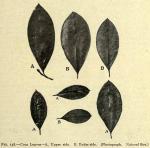49. Erythroxyllaceae.
265. Coca.—Coca (U.S.P. VIII)
 The dried leaves of Erythrox'ylon Co'ca Lamarack (Fam. Erythroxyllaceae,) known commonly as Huanuco (Bolivian) Coca, or of E. Truxillense Rusby, known commercially as Truxillo (Peruvian) Coca, yielding, when assayed by U.S.P. process, not less than 0.5 per cent. of ether-soluble alkaloids of coca.
The dried leaves of Erythrox'ylon Co'ca Lamarack (Fam. Erythroxyllaceae,) known commonly as Huanuco (Bolivian) Coca, or of E. Truxillense Rusby, known commercially as Truxillo (Peruvian) Coca, yielding, when assayed by U.S.P. process, not less than 0.5 per cent. of ether-soluble alkaloids of coca.
BOTANICAL CHARACTERISTICS.—Shrub about 6 feet high, with bright green leaves, size and shape similar to those of tea, and white blossoms, which are succeeded by small scarlet berries. When the leaves mature, the branches are stripped and the leafless plant is soon again covered with verdant foliage. The plant is propagated in nurseries from the seed.
SOURCE.—The shrub bearing coca leaves is extensively cultivated on the slopes of the Andes about 2,000 to 5,000 feet above the sea level, in Peru and Bolivia. The province of La Paz in Bolivia produces about the largest crops. That of Bolivia is considered superior to the Peruvian, although the latter country produces double the quantity. In this latter country, especially owing to the European demand, the cultivation has considerably increased. The annual production reaches the enormous figures of about one hundred million pounds. Two varieties, "Truxillo" and "Huanuco," having different characteristics, come to this market, the former named after the port Trujillo in the northern part of Peru, and the latter from the city of Huanuco, in the central part of Peru. The culture of coca leaves has been tried in other countries, but with questionable results, except, perhaps, on the Island of Java. The plant yields its first crop when eighteen months old, and continues to bear about forty years. There are two pickings —and September; the latter is considered the best and most abundant. The leaves are laid out in a paved drying yard and afterward pressed in drums (tambors) of plantain leaves, the tambor weighing forty pounds net.
DESCRIPTION OF DRUG.—Huanuco Coca.—Greenish-brown to clear brown, smooth and slightly glossy, thickish and slightly coriaceous, stoutly and very short petioled; blade 2.5 to 7.5 cm. long and nearly elliptical, with a very short and abruptly narrowed basal portion and a. short point, the margin entire; midrib traversed above by a slight ridge, very prominent underneath, the remaining venation obscure, especially above; underneath, two conspicuous lines of collenchyma tissue run longitudinally on either side of the midrib and about one-third of the distance between it and the margin, the enclosed areola being of a slightly different color from the adjacent surface; odor characteristic; taste bitterish, faintly aromatic, followed by a numbness of the tongue, lips, and fauces.
Truxillo Coca.—Pale green, thin, brittle and usually much broken, smooth but not shining, shortly and stoutly petioled; blade 1.6 to 5 cm. long and one-third to one-half as broad, obovate to oblanceolate, narrowed from near the middle into the petiole, usually with a slight projecting point at the summit, the margin entire; underneath two irregular lines of collenchyma tissue, usually incomplete or obscure, and frequently wanting, run beside the midrib; odor more tea-like than that of Huanuco Coca; taste and numbing effect similar.
Powder.—Greenish. Characteristic elements: Calcium oxalate of parenchyma in prisms, 3 to 10 µ in diam.; sclerenchyma, bast, and crystal fibers; small papillae on under epidermal cells.
CONSTITUENTS.—A volatile liquid alkaloid, hygrine, and cocaine (C17H21NO4), which has been found to be a compound body represented in a methyl benzoyl compound of another organic base, ecgonine (C9H16NO3). There are also present in the leaves benzoyl ecgonine, a methyl compound of which constitutes the alkaloid cocaine. This complex body cocaine is readily decomposed into its component parts, methyl alcohol, benzoic acid, and ecgonine, by heating with HCl. Hydrochloric acid is, therefore, unsuitable for the extraction of cocaine in the process of its manufacture. The percentage of cocaine varies greatly, hence it is important to assay the leaves and its preparations. Assay shows an average of 0.5 per cent. of ether-soluble alkaloids of the leaf.
Preparation of Cocaine.—Exhaust the powdered drug by repercolation with water acidulated with 5 per cent. H2SO4. Agitate the concentrated liquid with pure coal oil and an excess of Na2CO3. The oily liquid is then shaken with acidulated water and again precipitated by Na2CO3 in the presence of ether. From the ethereal solution the alkaloid can be obtained on evaporation.
COCAINA (U.S.P. IX).—Cocaine. Average dose: 0.015 Gm. (¼ gr.).
ACTION AND USES.—Stimulant to digestion, the brain, and respiration. Checks the process of wasting, enabling the laborer to endure a greater amount of physical exertion with a small amount of food. For this purpose the leaves are habitually chewed by the natives. Dose: 15 to 60 gr. (1 to 4 Gm.). Cocaine is a valuable local anaesthetic. Applied to mucous surfaces and injected subcutaneously. Dose: ½ to 1 gr. (0.0324 to 0.064 Gm.).
Solutions of the alkaloid in olive and castor oil are stable. Cocaine hydrochloride ointment should not be made with lard or vaseline, as it is insoluble in these fats. If the hydrochloride be dissolved in a little water before admixture, a stable ointment is effected.
COCA PRAEPARATA, N.F. 1 to 4 fl. dr. (4 to 15 Mils) .

